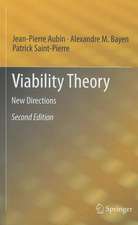The Interval Market Model in Mathematical Finance: Game-Theoretic Methods: Static & Dynamic Game Theory: Foundations & Applications
Autor Pierre Bernhard, Jacob C. Engwerda, Berend Roorda, J.M. Schumacher, Vassili Kolokoltsov, Patrick Saint-Pierre, Jean-Pierre Aubinen Limba Engleză Hardback – 14 dec 2012
A self-contained monograph, The Interval Market Model in Mathematical Finance: Game-Theoretic Methods assembles some of the most important results, old and new, in this area of research. Written by seven of the most prominent pioneers of the interval market model and game-theoretic finance, the work provides a detailed account of several closely related modeling techniques for an array of problems in mathematical economics. The book is divided into five parts, which successively address topics including:
· probability-free Black-Scholes theory;
· fair-price interval of an option;
· representation formulas and fast algorithms for option pricing;
· rainbow options;
· tychastic approach of mathematical finance based upon viability theory.
This book provides a welcome addition to the literature, complementing myriad titles on the market that take a classical approach to mathematical finance. It is a worthwhile resource for researchers in applied mathematics and quantitative finance, and has also been written in a manner accessible to financially-inclined readers with a limited technical background.
| Toate formatele și edițiile | Preț | Express |
|---|---|---|
| Paperback (1) | 391.99 lei 6-8 săpt. | |
| Springer – 28 ian 2015 | 391.99 lei 6-8 săpt. | |
| Hardback (1) | 399.50 lei 6-8 săpt. | |
| Springer – 14 dec 2012 | 399.50 lei 6-8 săpt. |
Preț: 399.50 lei
Nou
Puncte Express: 599
Preț estimativ în valută:
76.44€ • 79.81$ • 63.27£
76.44€ • 79.81$ • 63.27£
Carte tipărită la comandă
Livrare economică 05-19 aprilie
Preluare comenzi: 021 569.72.76
Specificații
ISBN-13: 9780817683870
ISBN-10: 0817683879
Pagini: 348
Ilustrații: XVI, 348 p.
Dimensiuni: 155 x 235 x 21 mm
Greutate: 0.69 kg
Ediția:2013
Editura: Springer
Colecția Birkhäuser
Seria Static & Dynamic Game Theory: Foundations & Applications
Locul publicării:New York, NY, United States
ISBN-10: 0817683879
Pagini: 348
Ilustrații: XVI, 348 p.
Dimensiuni: 155 x 235 x 21 mm
Greutate: 0.69 kg
Ediția:2013
Editura: Springer
Colecția Birkhäuser
Seria Static & Dynamic Game Theory: Foundations & Applications
Locul publicării:New York, NY, United States
Public țintă
ResearchCuprins
Preface.- Part I Revisiting Two Classic Results in Dynamic Portfolio Management.- Merton’s Optimal Dynamic Portfolio Revisited.- Option Pricing: Classic Results.- Introduction.- Part II Hedging in Interval Models.- Fair Price Intervals.- Optimal Hedging Under Robust-Cost Constraints.- Appendix: Proofs.- Continuous and Discrete-Time Option Pricing and Interval Market Model.- Part III Robust-Control Approach to Option Pricing.- Vanilla Options.- Digital Options.- Validation.- Introduction.- Part IV Game-Theoretic Analysis of Rainbow Options in Incomplete Markets.- Emergence of Risk-Neutral Probabilities.- Rainbow Options in Discrete Time, I.- Rainbow Options in Discrete Time, II.- Continuous-Time Limits.- Credit Derivatives.- Computational Methods Based on the Guaranteed Capture Basin Algorithm.- Viability Approach to Complex Option Pricing and Portfolio Insurance.- Asset and Liability Insurance Management (ALIM) for Risk Eradication.- References.- Index.
Textul de pe ultima copertă
Toward the late 1990s, several research groups independently began developing new, related theories in mathematical finance. These theories did away with the standard stochastic geometric diffusion “Samuelson” market model (also known as the Black-Scholes model because it is used in that most famous theory), instead opting for models that allowed minimax approaches to complement or replace stochastic methods. Among the most fruitful models were those utilizing game-theoretic tools and the so-called interval market model. Over time, these models have slowly but steadily gained influence in the financial community, providing a useful alternative to classical methods.
A self-contained monograph, The Interval Market Model in Mathematical Finance: Game-Theoretic Methods assembles some of the most important results, old and new, in this area of research. Written by seven of the most prominent pioneers of the interval market model and game-theoretic finance, the work provides a detailed account of several closely related modeling techniques for an array of problems in mathematical economics. The book is divided into five parts, which successively address topics including:
· probability-free Black-Scholes theory;
· fair-price interval of an option;
· representation formulas and fast algorithms for option pricing;
· rainbow options;
· tychastic approach of mathematical finance based upon viability theory.
This book provides a welcome addition to the literature, complementing myriad titles on the market that take a classical approach to mathematical finance. It is a worthwhile resource for researchers in applied mathematics and quantitative finance, and has also been written in a manner accessible to financially-inclined readers with a limited technical background.
A self-contained monograph, The Interval Market Model in Mathematical Finance: Game-Theoretic Methods assembles some of the most important results, old and new, in this area of research. Written by seven of the most prominent pioneers of the interval market model and game-theoretic finance, the work provides a detailed account of several closely related modeling techniques for an array of problems in mathematical economics. The book is divided into five parts, which successively address topics including:
· probability-free Black-Scholes theory;
· fair-price interval of an option;
· representation formulas and fast algorithms for option pricing;
· rainbow options;
· tychastic approach of mathematical finance based upon viability theory.
This book provides a welcome addition to the literature, complementing myriad titles on the market that take a classical approach to mathematical finance. It is a worthwhile resource for researchers in applied mathematics and quantitative finance, and has also been written in a manner accessible to financially-inclined readers with a limited technical background.
Caracteristici
First book on the market to highlight the interval market model in mathematical finance Combines several related paths of research into a single source, while providing numerous unpublished results Presented in a manner accessible to readers specializing in both mathematics and finance Includes many features to clarify concepts and facilitate referencing, such as figures, tables, biographical data, and subject, author, and notation indices

































